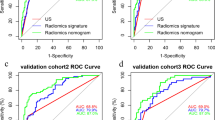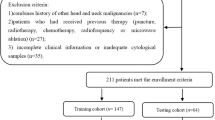Abstract
Digital pathology uses digitized images for cancer research. We aimed to assess morphometric parameters using digital pathology for predicting recurrence in patients with papillary thyroid carcinoma (PTC) and lateral cervical lymph node (LN) metastasis. We analyzed 316 PTC patients and assessed the longest diameter and largest area of metastatic focus in LNs using a whole slide imaging scanner. In digital pathology assessment, the longest diameters and largest areas of metastatic foci in LNs were positively correlated with traditional optically measured diameters (R = 0.928 and R2 = 0.727, p < 0.001 and p < 0.001, respectively). The optimal cutoff diameter was 8.0 mm in both traditional microscopic (p = 0.009) and digital pathology (p = 0.016) evaluations, with significant differences in progression-free survival (PFS) observed at this cutoff (p = 0.006 and p = 0.002, respectively). The predictive area’s cutoff was 35.6 mm2 (p = 0.005), which significantly affected PFS (p = 0.015). Using an 8.0-mm cutoff in traditional microscopic evaluation and a 35.6-mm2 cutoff in digital pathology showed comparable predictive results using the proportion of variation explained (PVE) methods (2.6% vs. 2.4%). Excluding cases with predominant cystic changes in LNs, the largest metastatic areas by digital pathology had the highest PVE at 3.9%. Furthermore, high volume of LN metastasis (p = 0.001), extranodal extension (p = 0.047), and high ratio of metastatic LNs (p = 0.006) were associated with poor prognosis. Both traditional microscopic and digital pathology evaluations effectively measured the longest diameter of metastatic foci in LNs. Moreover, digital pathology offers limited advantages in predicting PFS of patients with lateral cervical LN metastasis of PTC, especially those without predominant cystic changes in LNs.




Similar content being viewed by others
Data Availability
The datasets generated during and/or analyzed during the current study are available from the corresponding author upon reasonable request.
References
Baxi V, Edwards R, Montalto M, Saha S (2022) Digital pathology and artificial intelligence in translational medicine and clinical practice. Modern Pathology 35:23–32.https://doi.org/10.1038/s41379-021-00919-2
Pell R, Oien K, Robinson M, et al. (2019) The use of digital pathology and image analysis in clinical trials. J Pathol Clin Res 5:81–90. https://doi.org/10.1002/cjp2.127
Kumar N, Gupta R, Gupta S (2020) Whole Slide Imaging (WSI) in pathology: current perspectives and future directions. Journal of Digital Imaging 33:1034–1040. https://doi.org/10.1007/s10278-020-00351-z
Yamashita R, Nishio M, Do RKG, Togashi K (2018) Convolutional neural networks: an overview and application in radiology. Insights into Imaging 9:611–629. https://doi.org/10.1007/s13244-018-0639-9
Abele N, Tiemann K, Krech T, et al. (2023) Noninferiority of artificial intelligence-assisted analysis of Ki-67 and estrogen/progesterone receptor in breast cancer routine diagnostics. Mod Pathol 36:100033. https://doi.org/10.1016/j.modpat.2022.100033
Vyas NS, Markow M, Prieto-Granada C, et al. (2016) Comparing whole slide digital images versus traditional glass slides in the detection of common microscopic features seen in dermatitis. Journal of Pathology Informatics 7:30. https://doi.org/10.4103/2153-3539.186909
Mukhopadhyay S, Feldman MD, Abels E, et al. (2018) Whole slide imaging versus microscopy for primary diagnosis in surgical pathology: a multicenter blinded randomized noninferiority study of 1992 cases (Pivotal Study). Am J Surg Pathol 42:39–52. https://doi.org/10.1097/pas.0000000000000948
Litjens G, Sánchez CI, Timofeeva N, et al. (2016) Deep learning as a tool for increased accuracy and efficiency of histopathological diagnosis. Sci Rep 6:26286. https://doi.org/10.1038/srep26286
Collins BT, Collins LE (2013) Assessment of malignancy for atypia of undetermined significance in thyroid fine-needle aspiration biopsy evaluated by whole-slide image analysis. Am J Clin Pathol 139:736–745. https://doi.org/10.1309/AJCPQU29GHXYSZRR
Takamatsu M, Yamamoto N, Kawachi H, et al. (2019) Prediction of early colorectal cancer metastasis by machine learning using digital slide images. Comput Methods Programs Biomed 178:155–161. https://doi.org/10.1016/j.cmpb.2019.06.022
Steiner DF, MacDonald R, Liu Y, et al. (2018) Impact of deep learning assistance on the histopathologic review of lymph nodes for metastatic breast cancer. Am J Surg Pathol 42:1636–1646. https://doi.org/10.1097/PAS.0000000000001151
Lin S, Samsoondar JP, Bandari E, et al. (2023) Digital quantification of tumor cellularity as a novel prognostic feature of non-small cell lung carcinoma. Mod Pathol 36:100055. https://doi.org/10.1016/j.modpat.2022.100055
Bouzin C, Saini ML, Khaing KK, et al. (2016) Digital pathology: elementary, rapid and reliable automated image analysis. Histopathology 68:888–896. https://doi.org/10.1111/his.12867
Hsieh AM, Polyakova O, Fu G, et al. (2018) Programmed death-ligand 1 expression by digital image analysis advances thyroid cancer diagnosis among encapsulated follicular lesions. Oncotarget 9:19767–19782. https://doi.org/10.18632/oncotarget.24833
J AAJ, V MAR (2017) Automatic classification of thyroid histopathology images using multi-classifier system. Multimedia Tools and Applications 76:18711–18730. https://doi.org/10.1007/s11042-017-4363-0
Gopinath B, Shanthi N (2013) Computer-aided diagnosis system for classifying benign and malignant thyroid nodules in multi-stained FNAB cytological images. Australas Phys Eng Sci Med 36:219–230. https://doi.org/10.1007/s13246-013-0199-8
Tsou P, Wu CJ (2019) Mapping driver mutations to histopathological subtypes in papillary thyroid carcinoma: applying a deep convolutional neural network. J Clin Med 8:1675. https://doi.org/10.3390/jcm8101675
Eftimie LG, Glogojeanu RR, Tejaswee A, et al. (2022) Differential diagnosis of thyroid nodule capsules using random forest guided selection of image features. Scientific Reports 12:21636. https://doi.org/10.1038/s41598-022-25788-w
Kim M, Jeon MJ, Oh HS, et al. (2018) Prognostic implication of N1b classification in the eighth edition of the tumor-node-metastasis staging system of differentiated thyroid cancer. Thyroid 28:496–503. https://doi.org/10.1089/thy.2017.0473
Contal C, O'Quigley J (1999) An application of changepoint methods in studying the effect of age on survival in breast cancer. Comput Stat Data Anal 30:253–270. https://doi.org/10.1016/S0167-9473(98)00096-6
Gurcan MN, Boucheron LE, Can A, Madabhushi A, Rajpoot NM, Yener B (2009) Histopathological image analysis: a review. IEEE Rev Biomed Eng 2:147–171. https://doi.org/10.1109/rbme.2009.2034865
Arvaniti E, Fricker KS, Moret M, et al. (2018) Automated Gleason grading of prostate cancer tissue microarrays via deep learning. Sci Rep 8:12054. https://doi.org/10.1038/s41598-018-30535-1
Cain EH, Saha A, Harowicz MR, Marks JR, Marcom PK, Mazurowski MA (2019) Multivariate machine learning models for prediction of pathologic response to neoadjuvant therapy in breast cancer using MRI features: a study using an independent validation set. Breast Cancer Res Treat 173:455–463. https://doi.org/10.1007/s10549-018-4990-9
Lee H, Lee DE, Park S, et al. (2019) Predicting response to neoadjuvant chemotherapy in patients with breast cancer: combined statistical modeling using clinicopathological factors and FDG PET/CT texture parameters. Clin Nucl Med 44:21–29. https://doi.org/10.1097/rlu.0000000000002348
Skrede OJ, De Raedt S, Kleppe A, et al. (2020) Deep learning for prediction of colorectal cancer outcome: a discovery and validation study. Lancet 395:350–360. https://doi.org/10.1016/s0140-6736(19)32998-8
Kezlarian B, Lin O (2021) Artificial intelligence in thyroid fine needle aspiration biopsies. Acta Cytologica 65:324–329. https://doi.org/10.1159/000512097
Aloqaily A, Polonia A, Campelos S, et al. (2021) Digital versus optical diagnosis of follicular patterned thyroid lesions. Head Neck Pathol 15:537–543. https://doi.org/10.1007/s12105-020-01243-y
Girolami I, Marletta S, Pantanowitz L, et al. (2020) Impact of image analysis and artificial intelligence in thyroid pathology, with particular reference to cytological aspects. Cytopathology 31:432–444. https://doi.org/10.1111/cyt.12828
Chain K, Legesse T, Heath JE, Staats PN (2019) Digital image-assisted quantitative nuclear analysis improves diagnostic accuracy of thyroid fine-needle aspiration cytology. Cancer Cytopathol 127:501–513. https://doi.org/10.1002/cncy.22120
Haugen BR, Alexander EK, Bible KC, et al. (2016) 2015 American Thyroid Association management guidelines for adult patients with thyroid nodules and differentiated thyroid cancer: the american thyroid association guidelines task force on thyroid nodules and differentiated thyroid cancer. Thyroid 26:1–133. https://doi.org/10.1089/thy.2015.0020
Deng Y, Zhu G, Ouyang W, et al. (2019) Size of the largest metastatic focus to the lymph node is associated with incomplete response of Pn1 papillary thyroid carcinoma. Endocrine Practice 25:887–898. https://doi.org/10.4158/EP-2018-0583
Acknowledgements
A part of this study was presented as an abstract at a spring meeting of the Korean Thyroid Association in 2023.
Funding
Dong Eun Song acknowledges support from the National Research Foundation of Korea Research Grant (2021R1F1A1045552) and a grant (2022IL0016) from the Asan Institute for Life Sciences, Asan Medical Center, Seoul, South Korea. The remaining authors have no funding to report.
Author information
Authors and Affiliations
Contributions
Chae A Kim: data collection (equal), formal analysis (lead), and writing—original draft and revision (lead). Hyeong Rok An: formal analysis (equal) and visualization of results (lead). Jungmin Yoo: data collection (equal) and data curation (equal). Yu-Mi Lee and Tae-Yon Sung: data collection (equal), interpretation of the results (equal), and writing—editing (equal). Won Gu Kim: conceptualization (supporting), interpretation of the results (lead), writing—review and editing (lead), and revision (supporting). Dong Eun Song: conceptualization (lead), pathology review (lead), writing—review and editing (lead), and revision (supporting). All the authors had full access to the data, took responsibility for the accuracy of the data analysis, and approved the final version of the manuscript.
Corresponding authors
Ethics declarations
Ethical Approval
This study was performed in line with the principles of the Declaration of Helsinki. The study protocol was reviewed and approved by the Institutional Review Board of the Asan Medical Center (IRB no: 2022-0791).
Informed Consent
Informed consent was obtained from all participants and/or their legal guardians.
Competing Interests
The authors declare no competing interests.
Additional information
Publisher's Note
Springer Nature remains neutral with regard to jurisdictional claims in published maps and institutional affiliations.
Supplementary Information
Below is the link to the electronic supplementary material.
Rights and permissions
Springer Nature or its licensor (e.g. a society or other partner) holds exclusive rights to this article under a publishing agreement with the author(s) or other rightsholder(s); author self-archiving of the accepted manuscript version of this article is solely governed by the terms of such publishing agreement and applicable law.
About this article
Cite this article
Kim, C.A., An, H.R., Yoo, J. et al. Morphometric Analysis of Lateral Cervical Lymph Node Metastasis in Papillary Thyroid Carcinoma Using Digital Pathology. Endocr Pathol (2023). https://doi.org/10.1007/s12022-023-09790-0
Accepted:
Published:
DOI: https://doi.org/10.1007/s12022-023-09790-0




